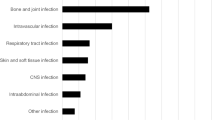Abstract
People who inject drugs (PWID) are susceptible to endovascular and deep-seated infections which require prolonged antibiotic therapy. There are concerns regarding this cohort’s suitability for outpatient parenteral antimicrobial therapy (OPAT), but relatively little published data. Our aim is to publish our outcomes in this setting, to inform other clinicians’ decisions regarding PWID in OPAT. We reviewed case records of all PWID in our OPAT service from July 2015 to December 2017. Successful completion of OPAT care was defined as completing the duration of parenteral therapy as planned at the outset, with expected clinical improvement. Data was collected on complications including hospital re-admission, new blood stream infections, patient non-compliance including ongoing non-prescribed intravenous drug use, and staff safety compromise. Twenty-eight of 38 (76.2%) episodes of OPAT care for PWID were completed successfully, with 724 bed days of care provided. The cohort was labour intensive to manage with high rates of re-admission, non-attendance and line-associated infections. There were no adverse events for staff safety, and no patient deaths on the programme. OPAT can be a viable option for PWID provided there is careful patient selection, good patient engagement and sufficient resources allocated for patient management.
Similar content being viewed by others
References
Mathers BM et al (2008) Global epidemiology of injecting drug use and HIV among people who inject drugs: a systematic review. Lancet 372(9651):1733–1745
Merz F (2017) United Nations Office on Drugs and Crime: World Drug Report 2017. SIRIUS-Zeitschrift für Strategische Analysen 2(1):85–86
Gordon RJ, Lowy FD (2005) Bacterial infections in drug users. N Engl J Med 353(18):1945–1954
Tice AD et al (2004) Practice guidelines for outpatient parenteral antimicrobial therapy. IDSA guidelines. Clin Infect Dis 38(12):1651–1672
Tice AD (2000) Pharmacoeconomic considerations in the ambulatory use of parenteral cephalosporins. Drugs 59(Suppl 3):29–35 discussion 47–9
Laupland KB, Valiquette L (2013) Outpatient parenteral antimicrobial therapy. Can J Infect Dis Med Microbiol 24(1):9–11
Mujal A et al (2016) Safety and effectiveness of outpatient parenteral antimicrobial therapy in older people. J Antimicrob Chemother 71(5):1402–1407
Camsari UM, Libertin CR (2017) Small-town America’s despair: infected substance users needing outpatient parenteral therapy and risk stratification. Cureus 9(8):e1579
Ho J et al (2012) International approaches to treating intravenous drug users in outpatient parenteral antibiotic services. Infect Dis Clin Pract 20:192–195. https://journals.lww.com/infectdis/Abstract/2012/05000/International_Approaches_to_Treating_Intravenous.8.aspx. Accessed 23 Dec 2018
Ho J et al (2010) Safe and successful treatment of intravenous drug users with a peripherally inserted central catheter in an outpatient parenteral antibiotic treatment service. J Antimicrob Chemother 65(12):2641–2644
Buehrle DJ et al (2017) Risk factors associated with outpatient parenteral antibiotic therapy program failure among intravenous drug users. Open Forum Infect Dis 4(3):ofx102
Dobson PM et al (2017) Comparing injecting drug users with others receiving outpatient parenteral antibiotic therapy. Open Forum Infect Dis 4(4):ofx183
Suzuki J et al (2018) Outpatient parenteral antimicrobial therapy among people who inject drugs: a review of the literature. Open Forum Infect Dis 5(9):ofy194
Beieler AM et al (2016) Successful implementation of outpatient parenteral antimicrobial therapy at a medical respite facility for homeless patients. J Hosp Med 11(8):531–535
Stafford J, Burns L (2010) AUSTRALIAN DRUG TRENDS 2009 findings from the Illicit Drug Reporting System (IDRS) Australian Drug Trends Series No. 37. National Drug and Alcohol Research Centre, University of New South Wales, Sydney
Author information
Authors and Affiliations
Corresponding author
Ethics declarations
Conflict of interest
The authors declare that they have no conflict of interest.
Additional information
Publisher’s note
Springer Nature remains neutral with regard to jurisdictional claims in published maps and institutional affiliations.
Rights and permissions
About this article
Cite this article
O’Callaghan, K., Tapp, S., Hajkowicz, K. et al. Outcomes of patients with a history of injecting drug use and receipt of outpatient antimicrobial therapy. Eur J Clin Microbiol Infect Dis 38, 575–580 (2019). https://doi.org/10.1007/s10096-018-03461-3
Received:
Accepted:
Published:
Issue Date:
DOI: https://doi.org/10.1007/s10096-018-03461-3




